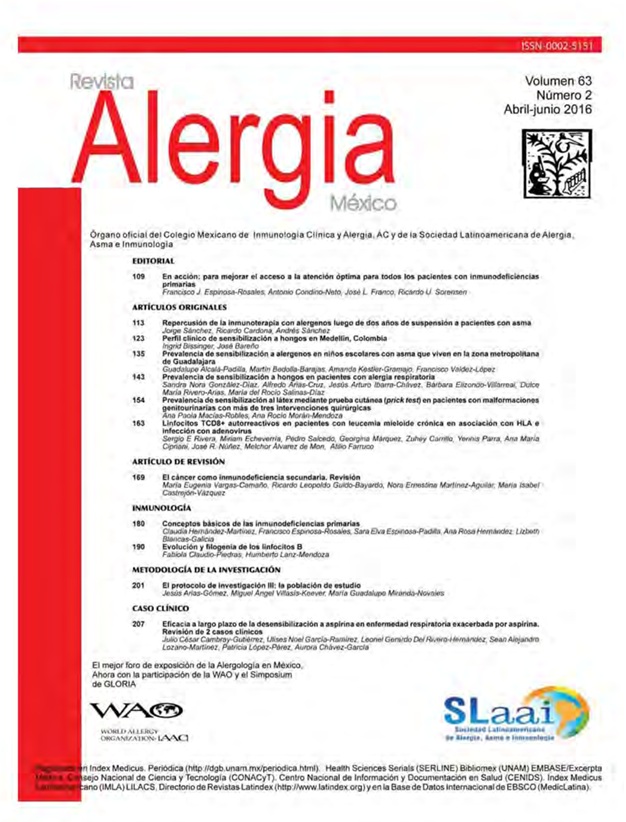Abstract
Background: Allergic sensitization is dependent on the geographical and climatic conditions in each region; therefore, identify agents most commonly sensitized children with asthma is important for planning prevention measures.
Objective: To determine the prevalence of the sensitization to allergens in children with asthma.
Material and method: This cross-sectional and prolective study, includes children from ages 6 to 14, who have asthma, attended for the first time in an allergy service. The patients were recruited consecutively between the months of January 1st 2014 to December 31st 2014. The frequency of the allergen sensitization was estimated.
Results: This study included 186 children, the median age was 7 years olds, the male group was 104/186 (55.9%) The median of the positive results was 5 and monosensitized were 47/186 (2.2%). The most common category of allergens was the indoor (90.3%), then trees (71.0%), and finally the fungi (9.7%). Individually, the house dust mites were more common in between the interior allergens, followed by the epithelial; in the tree pollen were oaks (31.7%) and ashes (28.0%), in weeds was mugwort (21.5%), in grasses was Zea mays(18.3%) and in the fungi was Cladosporium spp. (6.5%).
Conclusion: The high prevalence of the sensitization to house dust mites and epithelial in children with asthma, stimulates to implement methods of environmental control for contributing a better control of the disease.
References
Lai CK, Beasley R, Crane J, et al. International Study of Asthma and Allergies in Childhood Phase Three Study Group. Global variation in the prevalence and severity of asthma symptoms: Phase Three of the International Study of Asthma and Allergies in Childhood (ISAAC). Thorax 2009;64:476-83.
Pearce N, Pekkanen J, Beasley R. How much asthma is really attributable to atopy? Thorax 1999;54:268-72.
Crimi P, Boidi M, Minale P, et al. Differences in prevalence of allergic sensitization in urban and rural school children. Ann Allergy Asthma Immunol 1999;83:252-6.
Yazicioglu M, Oner N, Celtik C, et al. Sensitization to common allergens, especially pollens, among children with respiratory allergy in the Trakya region of Turkey. Asian Pac J Allergy Immunol 2004;22:183-90.
Baeza Bacab MA, Dávila Velázquez JR, Loeza Medina SR. Prevalencia de pruebas cutáneas positivas a alérgenos intradomiciliarios en preescolares con alergia respiratoria en Mérida, Yucatán, México. Rev Alerg Mex 2005;52:237-42.
Koshak EA. Skin test reactivity to indoor allergens correlates with asthma severity in jeddah, saudi arabia. Allergy Asthma Clin Immunol 2006;2:11-9.
Rastogi D, Reddy M, Neugebauer R. Comparison of patterns of allergen sensitization among inner-city Hispanic and African American children with asthma. Ann Allergy Asthma Immunol 2006;97:636-42.
Oluwole O, Arinola OG, Falade GA, et al. Allergy sensitization and asthma among 13-14 year old school children in Nigeria. Afr Health Sci 2013;13:144-53.
Bibi H, Shoseyov D, Feigenbaum D, et al. Comparison of positive allergy skin tests among asthmatic children from rural and urban areas living within small geographic area. Ann Allergy Asthma Immunol 2002;88:416-20.
Majkowska-Wojciechowska B, Pełka J, Korzon L, et al. Prevalence of allergy, patterns of allergic sensitization and allergy risk factors in rural and urban children. Allergy 2007;62:1044-50.
Li J, Sun B, Huang Y, Lin X, Zhao D, Tan G, et al. China Alliance of Research on Respiratory Allergic Disease. A multicentre study assessing the prevalence of sensitizations in patients with asthma and/or rhinitis in China. Allergy 2009;64:1083-92.
Larenas-Linnemann D, Michels A, Dinger H, et al. Allergen sensitization linked to climate and age, not to intermittent-persistent rhinitis in a cross-sectional cohort study in the (sub)tropics. Clin Transl Allergy 2014;4:20.
Global Initiative for Asthma: GINA report, Global Strategy for Asthma manegement and Prevention. Revisado 2012. [Consultado 15 agosto 2013] Disponible en: http://www.ginasthma.org/local/uploads/files/GINA_Report_March13.pdf
Baena-Cagnani CE, Solé D, González-Díaz SN, et al. Actualización de rinitis alérgica y su impacto en el asma (ARIA 2008). La perspectiva latinoamericana. Rev Alergia Mex. 2009; 56: 56-63.
Giachetti A, Greco MF, Scacchi MF, et al. Consenso Nacional de Dermatitis Atópica 2013. Comité Nacional de Dermatología. Arch Argent Pediatr 2014;112:293-4.
van Kampen V, de Blay F, Folletti I, et al. EAACI position paper: skin prick testing in the diagnosis of occupational type I allergies. Allergy 2013; 68: 580-4.
Kalliel JN, Goldstein BM, Braman SS, et al. High frequency of atopic asthma in a pulmonary clinic population. Chest 1989;96:1336-40.
Bedolla-Barajas M, Hernández-Colín DD, Sainz-Hernández J, et al. Sensibilización a alérgenos en adultos mexicanos con asma; la experiencia en un hospital escuela. Rev Alerg Mex 2011;58:133-41.
Mallol J, Raby P, Cambiazo D, et al. Prevalencia y perfil de sensibilización a aeroalérgenos en 1.199 niños asmáticos: serie consecutiva de casos. Rev Med Chil 2014;142:567-73.
Hosseini S, Shoormasti RS, Akramian R, et al. Skin prick test reactivity to common aero and food allergens among children with allergy. Iran J Med Sci 2014;39:29-35.
Raj D, Lodha R, Pandey A, et al. New Delhi Childhood Asthma Study Group. Aeroallergen Sensitization in Childhood Asthmatics in Northern India. Indian Pediatr 2013;50:1113-8.
Díaz Vázquez CA, Rodríguez García J, Sánchez Iglesias G. Perfil de sensibilización a neumoalérgenos en niños con asma y rinoconjuntivitis en una zona de salud de Asturias. Bol Pediatr 2003;43:3-12.
Ghaffari J, Khademloo M, Saffar MJ, et al. Hypersensitivity to House Dust Mite and Cockroach Is the Most Common Allergy in North of Iran. Iran J Immunol 2010;7:234-9.
Suphioglu C, Singh MB, Taylor P, et al. Mechanism of grass-pollen-induced asthma. Lancet 1992; 339: 569-72.
Sarpong SB, Karrison T.Skin test reactivity to indoor allergens as a marker of asthma severity in children with asthma. Ann Allergy Asthma Immunol 1998;80:303-8.

This work is licensed under a Creative Commons Attribution-NonCommercial 4.0 International License.
Copyright (c) 2016 Revista Alergia México

